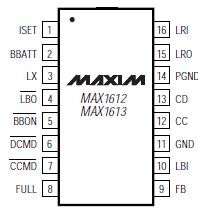Features: ` Reduce Battery Size and Cost
` Four Key Circuit Blocks
Adjustable Boost DC-DC Converter
NiCd/NiMH Trickle Charger
Always-On Linear Regulator (+28V Input)
Low-Battery Detector
` Low 18A Quiescent Current
` Selectable Charging/Discharging Rates
` Preset Linear-Regulator Voltage
5V (MAX1612)
3.3V (MAX1613)
` 4V to 28V Main Input Voltage Range
` Internal Switch Boost Converter
` Small 16-Pin QSOP PackageApplication · Notebook Computers
· Portable Equipment
· Backup Battery ApplicationsPinout Specifications
SpecificationsLRI, ISET to GND....................................................-0.3V to +30V
LX to GND .............................................................-0.3V to +14V
PGND to GND .......................................................-0.3V to +0.3V
BBATT, LRO, CCMD, DCMD, FULL, BBON,
LBO to GND ..........................................................-..0.3V to +6V
CC, CD, LBI, FB to GND.............................-0.3V to (VLRO + 0.3V)
FB, LBI, ISET, and BBATT Current.......................................50mA
LRO Output Current ..........................................................50mA
Continuous Power Dissipation (TA = +70°C)
QSOP (derate 8.30mW/°C above +70°C)...................... 667mW
Operating Temperature Range
MAX1612/MAX1613EEE .....................................-40°C to +85°C
Storage Temperature Range ..........................-65°C to +160°C
Lead Temperature (soldering, 10sec) ...........................+300°C
Stresses beyond those listed under "Absolute Maximum Ratings" may cause permanent damage to the device. These are stress ratings only, and functional operation of the device at these or any other conditions beyond those indicated in the operational sections of the specifications is not implied. Exposure to absolute maximum rating conditions for extended periods may affect device reliability.
DescriptionThe MAX1612/MAX1613 manage the bridge battery (sometimes called a hot-swap or auxiliary battery) in portable systems such as notebook computers. They feature a step-up DC-DC converter that boosts 2-cell or 3-cell bridge-battery voltages up to the same level as the main battery. This voltage boosting technique reduces the number of cells otherwise required for a 6-cell plus diode-OR bridging scheme, reducing overall size and cost. Another key feature is a trickle-charge timer that minimizes battery damage caused by constant charging and eliminates trickle-charge current drain on the main battery once the bridge battery is topped off.
These MAX1612/MAX1613 contain a highly flexible collection of independent circuit blocks that can be wired together in an autonomous stand-alone configuration or used in conjunction with a microcontroller. In addition to the boost converter and charge timer, there is a micropower linear regulator (useful for RTC/CMOS backup as well as for powering a microcontroller) and a high-precision low-battery detection comparator.
The two devices differ only in the preset linear-regulator output voltage: +5.0V for the MAX1612 and +3.3V for the MAX1613. Both devices come in a space-saving 16-pin QSOP package.

 MAX1613 Data Sheet
MAX1613 Data Sheet







